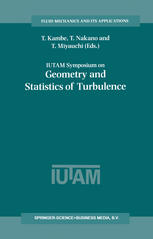

Most ebook files are in PDF format, so you can easily read them using various software such as Foxit Reader or directly on the Google Chrome browser.
Some ebook files are released by publishers in other formats such as .awz, .mobi, .epub, .fb2, etc. You may need to install specific software to read these formats on mobile/PC, such as Calibre.
Please read the tutorial at this link: https://ebookbell.com/faq
We offer FREE conversion to the popular formats you request; however, this may take some time. Therefore, right after payment, please email us, and we will try to provide the service as quickly as possible.
For some exceptional file formats or broken links (if any), please refrain from opening any disputes. Instead, email us first, and we will try to assist within a maximum of 6 hours.
EbookBell Team

0.0
0 reviewsThis volume contains the papers presented at the IUTAM Symposium on Geometry and Statistics of Turbulence, held in November 1999, at the Shonan International Village Center, Hayama (Kanagawa-ken), Japan. The Symposium was proposed in 1996, aiming at organizing concen trated discussions on current understanding of fluid turbulence with empha sis on the statistics and the underlying geometric structures. The decision of the General Assembly of International Union of Theoretical and Applied Mechanics (IUTAM) to accept the proposal was greeted with enthusiasm. Turbulence is often characterized as having the properties of mixing, inter mittency, non-Gaussian statistics, and so on. Interest is growing recently in how these properties are related to formation and evolution of struc tures. Note that the intermittency is meant for passive scalars as well as for turbulence velocity or rate of dissipation. There were eighty-eight participants in the Symposium. They came from thirteen countries, and fifty-seven papers were presented. The presenta tions comprised a wide variety of fundamental subjects of mathematics, statistical analyses, physical models as well as engineering applications. Among the subjects discussed are (a) Degree of self-similarity in cascade, (b) Fine-scale structures and degree of Markovian property in turbulence, (c) Dynamics of vorticity and rates of strain, (d) Statistics associated with vortex structures, (e) Topology, structures and statistics of passive scalar advection, (f) Partial differential equations governing PDFs of velocity in crements, (g) Thermal turbulences, (h) Channel and pipe flow turbulences, and others.